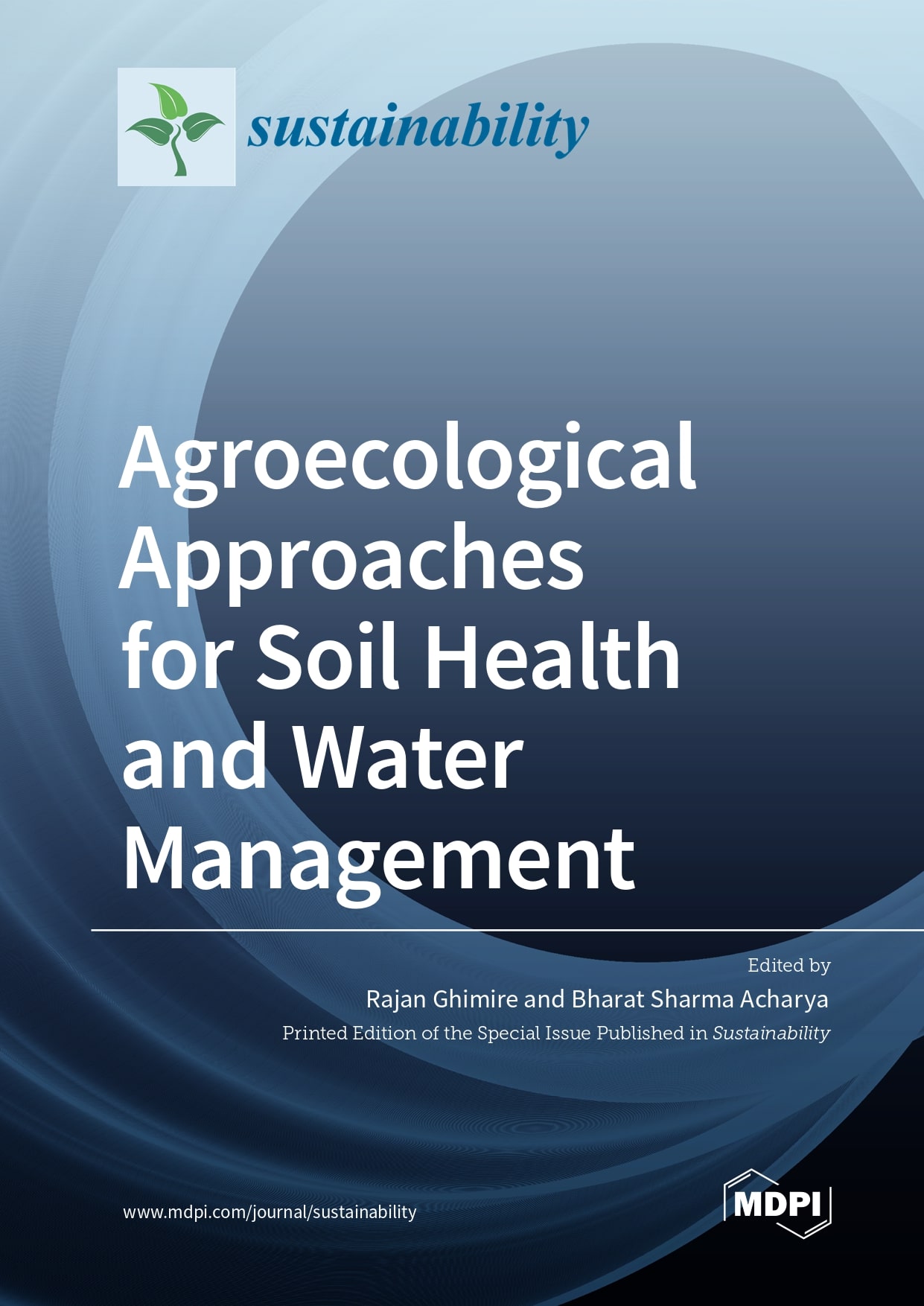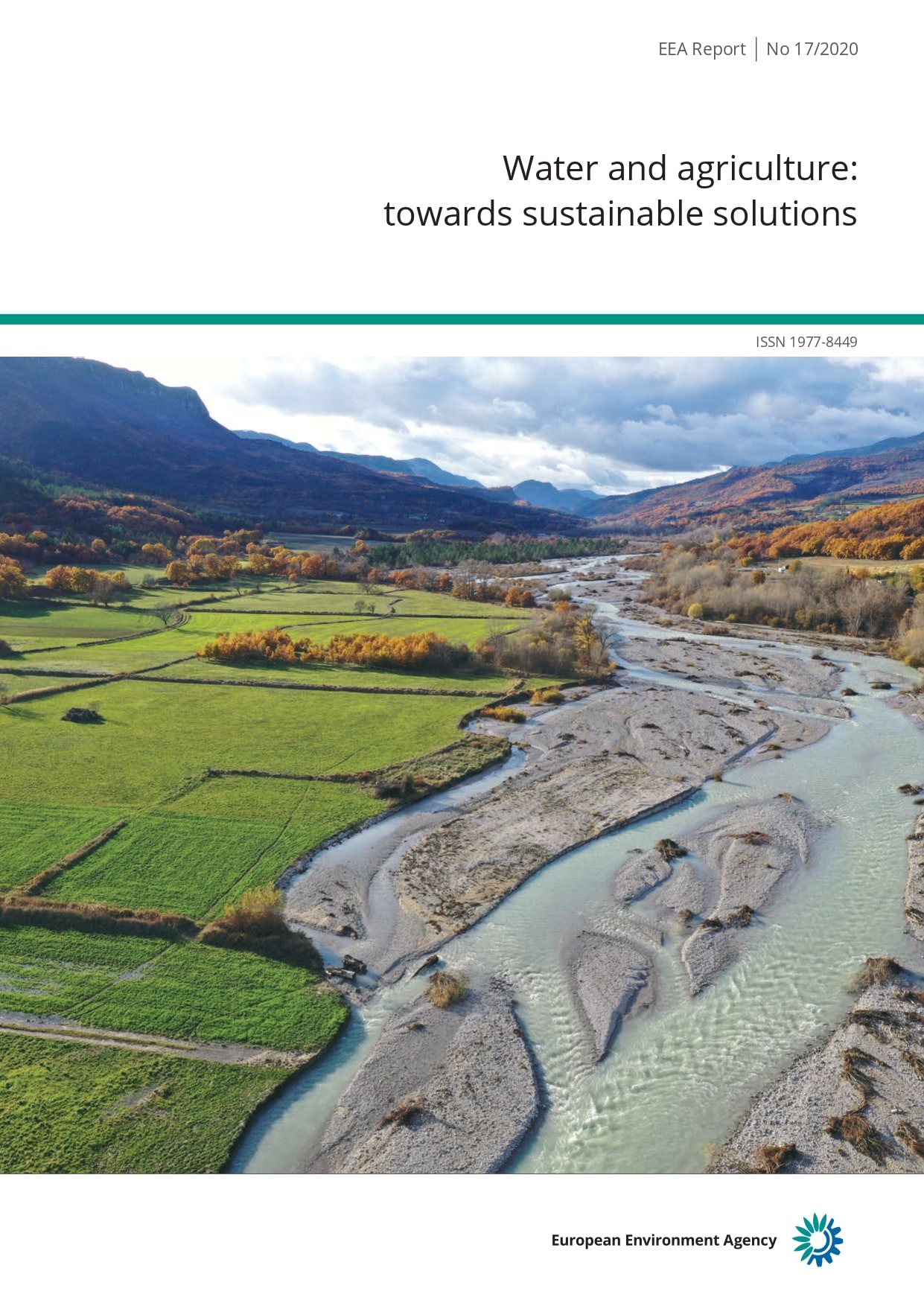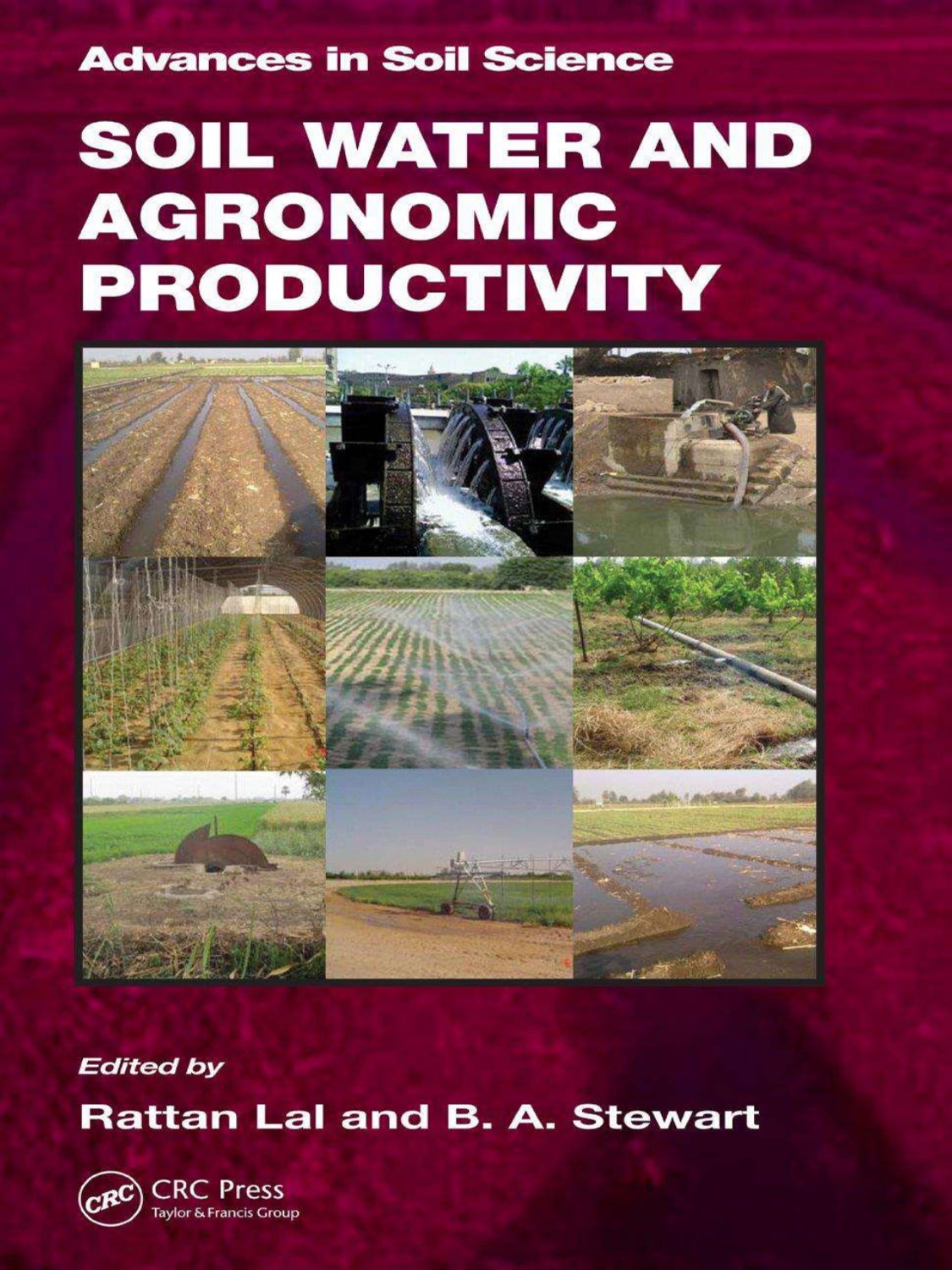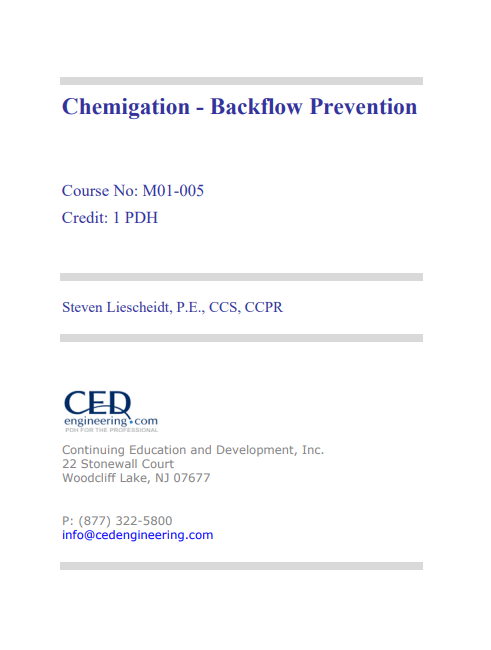Rainfall Erosivity in Soil Erosion Processes
Rainfall Erosivity in Soil Erosion Processes
Source: https://www.mdpi.com
Edited by: Gianni Bellocchi and Nazzareno Diodato
Usually dispatched in 2 to 3 days
Usually dispatched in 2 to 3 days
Category:
Irrigation & Agriculture
Abstract: Regional studies on the erosive power of rainfall patterns are still limited and the actual impacts that may follow on erosional and sedimentation processes are poorly understood. Given the several interrelated challenges of environmental management, it is also not always unclear what is relevant for the development of adaptive and integrated approaches facilitating sustainable water resource management.
Only logged in customers who have purchased this product may leave a review.
Related products
Sustainable Use of Soils and Water: The Role of Environmental Land Use Conflicts
This book on the sustainable use of soils and water addressed a variety of issues related to the utopian desire for environmental sustainability and the deviations from this scene observed in the real world. Competing interests for land are frequently a factor in land degradation, especially where the adopted land uses do not conform with the land capability (the natural use of soil). The concerns of researchers about these matters are presented in the articles comprising this Special Issue book. Various approaches were used to assess the (im)balance between economic profit and environmental conservation in various regions, in addition to potential routes to bring landscapes back to a sustainable status being disclosed.
Sustainable Use of Soils and Water: The Role of Environmental Land Use Conflicts
This book on the sustainable use of soils and water addressed a variety of issues related to the utopian desire for environmental sustainability and the deviations from this scene observed in the real world. Competing interests for land are frequently a factor in land degradation, especially where the adopted land uses do not conform with the land capability (the natural use of soil). The concerns of researchers about these matters are presented in the articles comprising this Special Issue book. Various approaches were used to assess the (im)balance between economic profit and environmental conservation in various regions, in addition to potential routes to bring landscapes back to a sustainable status being disclosed.
Watering Floodplain Wetlands in the Murray–Darling Basin to Benefit Native Fish A Discussion with Managers
This report describes the content and outcomes of a workshop entitled ‘Watering Floodplain Wetlands of the Murray–Darling Basin for Fish: A Discussion with Managers’ held on 5 March 2008 at Wonga Wetlands in Albury (NSW). The workshop was part of a four-year, National Water Commission funded project aimed at optimizing wetland environmental watering protocols to maximize benefits to native fish populations.
Watering Floodplain Wetlands in the Murray–Darling Basin to Benefit Native Fish A Discussion with Managers
This report describes the content and outcomes of a workshop entitled ‘Watering Floodplain Wetlands of the Murray–Darling Basin for Fish: A Discussion with Managers’ held on 5 March 2008 at Wonga Wetlands in Albury (NSW). The workshop was part of a four-year, National Water Commission funded project aimed at optimizing wetland environmental watering protocols to maximize benefits to native fish populations.
Modelling and Management of Irrigation System
Irrigation is becoming an activity of precision, where combining information collected from various sources is necessary to optimally manage resources. New management strategies, such as big data techniques, sensors, artificial intelligence, unmanned aerial vehicles (UAV), and new technologies in general, are becoming more relevant every day. As such, modeling techniques, both at the water distribution network and the farm levels, will be essential to gather information from various sources and offer useful recommendations for decision-making processes. In this book, 10 high quality papers were selected that cover a wide range of issues that are relevant to the different aspects related to irrigation management: water source and distribution network, plot irrigation systems, and crop water management.
Modelling and Management of Irrigation System
Irrigation is becoming an activity of precision, where combining information collected from various sources is necessary to optimally manage resources. New management strategies, such as big data techniques, sensors, artificial intelligence, unmanned aerial vehicles (UAV), and new technologies in general, are becoming more relevant every day. As such, modeling techniques, both at the water distribution network and the farm levels, will be essential to gather information from various sources and offer useful recommendations for decision-making processes. In this book, 10 high quality papers were selected that cover a wide range of issues that are relevant to the different aspects related to irrigation management: water source and distribution network, plot irrigation systems, and crop water management.
Water Productivity of Irrigated Agriculture in India Potential areas for improvement
Abstract
The objective of this paper is to estimate water productivity in irrigated agriculture in selected basins in India; and to identify the drivers of change in water productivity in these regions.
Water Productivity of Irrigated Agriculture in India Potential areas for improvement
Abstract
The objective of this paper is to estimate water productivity in irrigated agriculture in selected basins in India; and to identify the drivers of change in water productivity in these regions.
A Benefit-cost Analysis Of Treated Wastewater Reuse For Irrigation In Tubas
The West Bank, Palestine suffers from water scarcity due to the high population growth rate, the political situation that dictates the utilization and development of the water resources and the arid and semiarid climate conditions. Reuse of treated wastewater can be a source of water for the
irrigation of agricultural crops and thus this will lessen the stress on the water resources, increase the agricultural productivity and prevent the pollution of
the soil and groundwater. This work investigated the feasibility of reusing treated wastewater for irrigation in the Tubas area. Thereafter, a benefit-cost analysis was carried out to estimate the cost of the reuse of the treated wastewater in Tubas area. The study considered five options for wastewater treatment in Tubas area: construction of a treatment plant for the wastewater originating from the north of Tubas, south of Tubas, north of Tubas and Tayaser village, all of Tubas, and all of Tubas and Tayaser village, respectively. The study analyzed three systems for secondary wastewater treatment: activated sludge (AS), trickling filter (TF) and aerated lagoons (AL).
Rated 5.00 out of 5
A Benefit-cost Analysis Of Treated Wastewater Reuse For Irrigation In Tubas
The West Bank, Palestine suffers from water scarcity due to the high population growth rate, the political situation that dictates the utilization and development of the water resources and the arid and semiarid climate conditions. Reuse of treated wastewater can be a source of water for the
irrigation of agricultural crops and thus this will lessen the stress on the water resources, increase the agricultural productivity and prevent the pollution of
the soil and groundwater. This work investigated the feasibility of reusing treated wastewater for irrigation in the Tubas area. Thereafter, a benefit-cost analysis was carried out to estimate the cost of the reuse of the treated wastewater in Tubas area. The study considered five options for wastewater treatment in Tubas area: construction of a treatment plant for the wastewater originating from the north of Tubas, south of Tubas, north of Tubas and Tayaser village, all of Tubas, and all of Tubas and Tayaser village, respectively. The study analyzed three systems for secondary wastewater treatment: activated sludge (AS), trickling filter (TF) and aerated lagoons (AL).
Rated 5.00 out of 5
Agroecological Approaches for Soil Health and Water Management
In the last century, innovations in agricultural technologies centered on maximizing food production to feed the growing population have contributed to significant changes in agroecosystem processes, including carbon, nutrients, and water cycling. There are growing concerns regarding soil fertility depletion, soil carbon loss, greenhouse gas emissions, irrigational water scarcity, and water pollution, affecting soil health, agricultural productivity, systems sustainability, and environmental quality. Soils provide the foundation for food production, soil water and nutrient cycling, and soil biological activities. Therefore, an improved understanding of biochemical pathways of soil organic matter and nutrient cycling, microbial community involved in regulating soil health, and soil processes associated with water flow and retention in soil profile helps design better agricultural systems and ultimately support plant growth and productivity. This book, Agroecological Approaches in Soil and Water Management, presents a collection of original research and review papers studying physical, chemical, and biological processes in soils and discusses multiple ecosystem services, including carbon sequestration, nutrients and water cycling, greenhouse gas emissions, and agro-environmental sustainability.
Agroecological Approaches for Soil Health and Water Management
In the last century, innovations in agricultural technologies centered on maximizing food production to feed the growing population have contributed to significant changes in agroecosystem processes, including carbon, nutrients, and water cycling. There are growing concerns regarding soil fertility depletion, soil carbon loss, greenhouse gas emissions, irrigational water scarcity, and water pollution, affecting soil health, agricultural productivity, systems sustainability, and environmental quality. Soils provide the foundation for food production, soil water and nutrient cycling, and soil biological activities. Therefore, an improved understanding of biochemical pathways of soil organic matter and nutrient cycling, microbial community involved in regulating soil health, and soil processes associated with water flow and retention in soil profile helps design better agricultural systems and ultimately support plant growth and productivity. This book, Agroecological Approaches in Soil and Water Management, presents a collection of original research and review papers studying physical, chemical, and biological processes in soils and discusses multiple ecosystem services, including carbon sequestration, nutrients and water cycling, greenhouse gas emissions, and agro-environmental sustainability.
Water and Agriculture: Towards Sustainable Solutions
The main pressures from agriculture are linked to diffuse pollution from nutrients and chemicals, water abstraction and hydromorphological changes. Often several pressures act at the same time, potentially increasing the range of ecological impacts. According to information reported under the WFD, around one third of surface water bodies fail to achieve good status because of one or several of these pressures.
Water and Agriculture: Towards Sustainable Solutions
The main pressures from agriculture are linked to diffuse pollution from nutrients and chemicals, water abstraction and hydromorphological changes. Often several pressures act at the same time, potentially increasing the range of ecological impacts. According to information reported under the WFD, around one third of surface water bodies fail to achieve good status because of one or several of these pressures.
Soil Water and Agronomic Productivity
The need for an efficient use of soil water is.also enhanced by the lack of availability of freshwater
supply for supplemental irrigation. Global water use for agriculture,.as a percentage of the total water
use,was 81.4% in 1900, 72.3% in 1950, 68.2% in 1975, and 56.7% in 2000. Global water use for urban
purposes (km 3/year) was 20 in 1900, 60 in 1950, 150 in 1975, and 440 in 2000. Similarly, global water
use (km 3/year) for industrial purposes was 30 in 1900, 190 in 1950, 630 in 1975, and 1900 in 2000
Availability of water for irrigation is also constrained by the diversion to fossil fuel production
and eutrophication/pollution of water resources. One liter of bioethanol production requires 3500L
of fresh water. Thus, there is a strong and prime need for conserving, recycling, and improving soil-
water resources to meet the food demands of the growing world population.
supply for supplemental irrigation. Global water use for agriculture,.as a percentage of the total water
use,was 81.4% in 1900, 72.3% in 1950, 68.2% in 1975, and 56.7% in 2000. Global water use for urban
purposes (km 3/year) was 20 in 1900, 60 in 1950, 150 in 1975, and 440 in 2000. Similarly, global water
use (km 3/year) for industrial purposes was 30 in 1900, 190 in 1950, 630 in 1975, and 1900 in 2000
Availability of water for irrigation is also constrained by the diversion to fossil fuel production
and eutrophication/pollution of water resources. One liter of bioethanol production requires 3500L
of fresh water. Thus, there is a strong and prime need for conserving, recycling, and improving soil-
water resources to meet the food demands of the growing world population.
Soil Water and Agronomic Productivity
The need for an efficient use of soil water is.also enhanced by the lack of availability of freshwater
supply for supplemental irrigation. Global water use for agriculture,.as a percentage of the total water
use,was 81.4% in 1900, 72.3% in 1950, 68.2% in 1975, and 56.7% in 2000. Global water use for urban
purposes (km 3/year) was 20 in 1900, 60 in 1950, 150 in 1975, and 440 in 2000. Similarly, global water
use (km 3/year) for industrial purposes was 30 in 1900, 190 in 1950, 630 in 1975, and 1900 in 2000
Availability of water for irrigation is also constrained by the diversion to fossil fuel production
and eutrophication/pollution of water resources. One liter of bioethanol production requires 3500L
of fresh water. Thus, there is a strong and prime need for conserving, recycling, and improving soil-
water resources to meet the food demands of the growing world population.
supply for supplemental irrigation. Global water use for agriculture,.as a percentage of the total water
use,was 81.4% in 1900, 72.3% in 1950, 68.2% in 1975, and 56.7% in 2000. Global water use for urban
purposes (km 3/year) was 20 in 1900, 60 in 1950, 150 in 1975, and 440 in 2000. Similarly, global water
use (km 3/year) for industrial purposes was 30 in 1900, 190 in 1950, 630 in 1975, and 1900 in 2000
Availability of water for irrigation is also constrained by the diversion to fossil fuel production
and eutrophication/pollution of water resources. One liter of bioethanol production requires 3500L
of fresh water. Thus, there is a strong and prime need for conserving, recycling, and improving soil-
water resources to meet the food demands of the growing world population.
Chemigation Backflow Prevention
Introduction
The purpose of this guide is to familiarize those injecting pesticides into irrigation systems with the federal government's equipment requirements on the pesticide label.
The guide will cover the legal requirements as well as discuss practical ways to meet the requirements.
Chemigation Backflow Prevention
Introduction
The purpose of this guide is to familiarize those injecting pesticides into irrigation systems with the federal government's equipment requirements on the pesticide label.
The guide will cover the legal requirements as well as discuss practical ways to meet the requirements.















Reviews
There are no reviews yet.